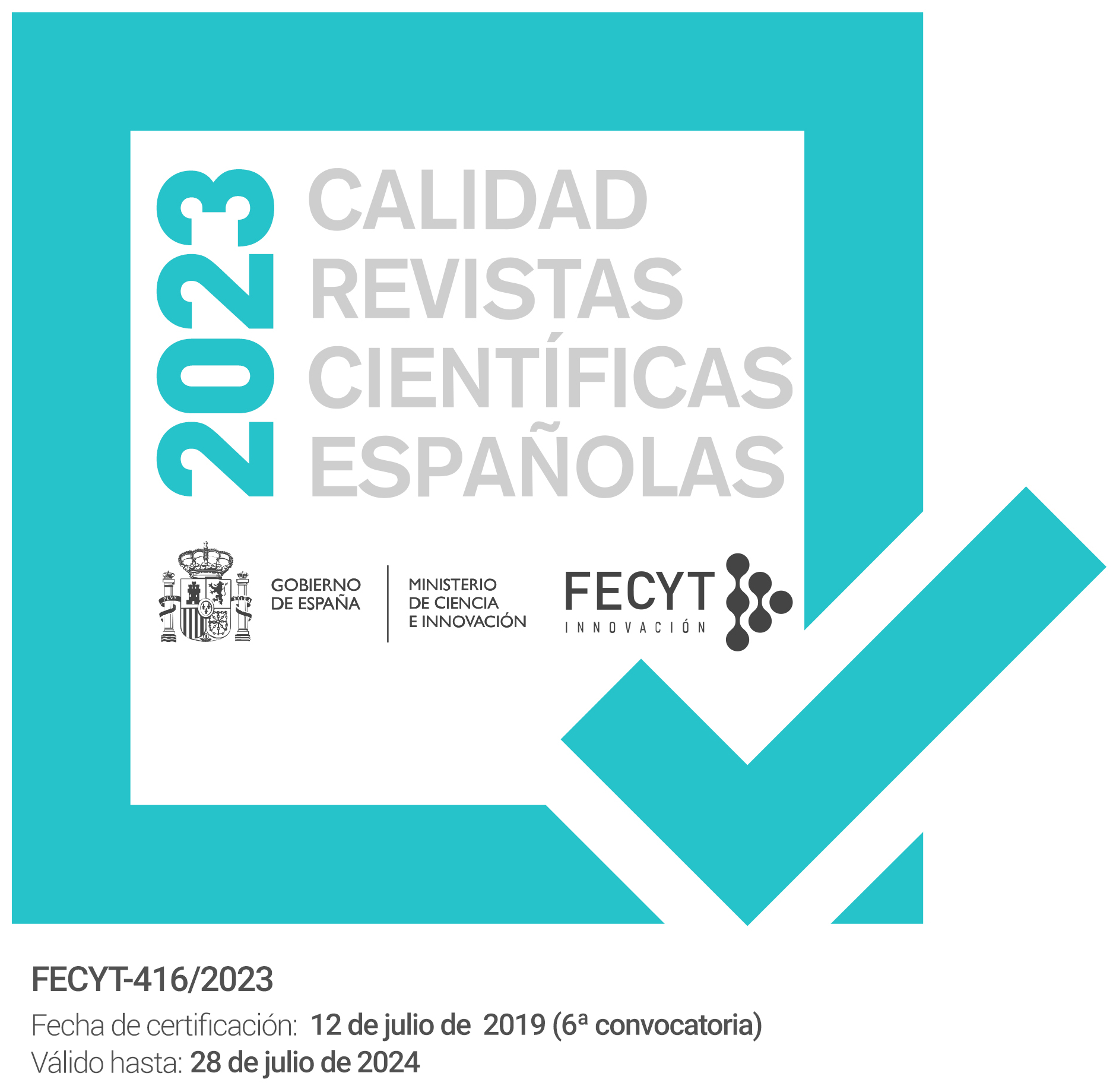The Interplay among Alchemy, Theology and Philosophy in the Late Middle Ages: The Cases of Roger Bacon and John of Rupescissa
Palabras clave:
Alchemy, Aristotelianism, Theology, Roger Bacon, John of RupescissaResumen
During the Late Middle Ages, alchemy attracted the interest of many eminent scholars, yet alchemy’s constant failure to produce the philosopher’s stone veiled the art with a cloak of scorn. In this article, I examine the cases of Roger Bacon and of John of Rupescissa, both of whom entwined alchemy with philosophy and theology, portraying the hermetic art as a salutary practice for humanity and the Church. Therefore, my scrutiny of their works aims to demonstrate alchemy’s desire, albeit somewhat implicit, for recognition and legitimization.Descargas
Citas
Bacon, R. (1859): Opera quaedam hactenus inedita Rogeri Baconi, vol.I, J. Brewer (ed.), London.
Bacon, R. (1897): The ‘Opus Majus’, vols. I-II, J. H. Bridges (ed.), Oxford.
Bacon, R. (1912): Part of the Opus tertium of Roger Bacon, A. G. Little (ed.), Aberdeen.
Bacon, R. (1920): Opera hactenus inedita Rogeri Baconi, Fasc.V: Secretum secretorum cum glossis et notulis Fratris Rogeri, Clarendon Press, R. Steele (ed.), Oxford.
Beretta, M. (1998): “Historiographie”, in C. Priesner and K. Figala (eds.), Alchemie: Lexicon einer hermetischen Wissenschaft, Verlag C. H. Beck, München: 178-181.
Brabner, T. (2005): “Alchemy”, in T. Glick, S. J. Livesey and F. Wallis (eds.), Medieval Science, Technology and Medicine: An Encyclopedia, Routledge, New York- London: 19-22.
Brehm, E. (1976): “Roger Bacon’s Place in the History of Alchemy”, Ambix 23: 53-58.
Crowley, T. (1950): Roger Bacon, The Problem of the Soul in his Philosophical Commentaries, Louvain.
De Vun, L. (2009): Prophesy, Alchemy, and the End of Time: John of Rupescissa in the Late Middle Ages, Columbia University Press, New York.
Haage, D. B. (2006): “Alchemy II: Antiquity- 12th Century”, in W. J. Hanegraaff (ed.), Dictionary of Gnosis and Western Esotericism, Brill, Leiden: 16-34.
Hackett, J. (1997): “Roger Bacon: His life, career and works”, in J. Hackett, (ed.), Roger Bacon and the Sciences: Commemorative Essays, Brill, Leiden: 9-24.
Halleux, R. (1981): “Les ouvrages alchimiques de Jean de Rupescissa”, Histoire Littéraire de la France 41: 241-284.
Magnus, A. (1890): De mineralibus, A. Borgnet (ed.), Paris.
Matus, Z. (2012): “Reconsidering Roger Bacon’s Apocalypticism in Light of His Alchemical and Scientific Thought”, Harvard Theological Review 105: 189-222.
Matus, Z. (2013): “Resurrected bodies and Roger Bacon’s elixir”, Ambix 60: 323-340.
Matus, Z. (2017): Franciscans and the Elixir of Life: Religion and Science in the Later Middle Ages, University of Pennsylvania Press, Philadelphia.
Mc Ginn, B. (1979): Visions of the End: Apocalyptic traditions in the Middle Ages, Columbia University Press, New York.
Mercer, J. E. (1921): Alchemy: Its Science and Romance, The MacMillan Company, New York.
Moureau, S. (2011): “Alchemy in the Latin World”, in H. Lagerlund (ed.), Encyclopedia of Medieval Philosophy: Philosophy between 500-1500, Springer, Dordrecht, Heidelberg, London, New York: 56-60.
Multhauf, R. (1954): “John of Rupescissa and the Origin of Medical Chemistry”, Isis 45 (4): 359-367.
Newman, W. (1989): “Technology and Alchemical Debate in the Late Middle Ages”, Isis 80 (3): 423-445.
Newman, W. (1994): “The Alchemy of Roger Bacon and the Tres Epistolae Attributed to Him”, in Comprendre et maîtriser la nature au moyen âge: Mélanges d’histoire des sciences offerts à Guy Beaujouan, Librairie Droz S.A., Genève.
Newman, W. (1997): “An Overview of Roger Bacon’s Alchemy”, in J. Hackett (ed.), Roger Bacon and the Sciences: Commemorative Essays, Brill, Leiden: 317-336.
Newman, W.; Principe, L. (1998): “Alchemy vs Chemistry: The Etymological Origins of a Historiographic Mistake”, Early Science and Medicine 3 (1): 32-65.
Newman, W. (2004): Promethean Ambitions: Alchemy and the Quest to Perfect Nature, The University of Chicago Press, Chicago and London.
Newman, W. (2011): “What Have We Learned from the Recent Historiography of Alchemy?”, Isis 102 (2): 313-321.
Newman, W. (2013): “Medieval Alchemy”, in D. C. Lindeberg and M. H. Shank (eds.), The Cambridge History of Science Volume 2: Medieval Science, The Cambridge University Press, New York: 385-403.
Nummedal, T. (2011): “Words and Works in the History of Alchemy”, Isis 102 (2): 330-337.
Nummedal, T. (2013): “Alchemy and Religion in Christian Europe”, Ambix 60 (4): 311-322.
Pereira, M. (2000): “Heavens on Earth. From the Tabula Smaragdina to the Alchemical Fifth Essence”, Early Science and Medicine 5 (2): 131-144.
Principe, L.; Newman, W. (2001): “Some Problems with the Historiography of Alchemy”, in Newman, W. R.; Grafton, A. (eds.), Secrets of Nature: Astrology and Alchemy in Early Modern Europe, The MIT Press, Massachusetts: 385-431.
Principe, L. (2013): The Secrets of Alchemy, The University of Chicago Press, Chicago.
Singer, D. (1932): “Alchemical Writings Attributed to Roger Bacon”, Speculum 7: 80-86.
Taylor, S. (1953): “The Idea of the Quintessence”, in E. A. Underwood (ed.), Science, Medicine and History: Essays on the Evolution of Scientific Thought and Medical Practice Written in Honour of Charles Singer, Oxford University Press, London: 247-265.
Thorndike, L. (1934): A History of Magic and Experimantal Science, vol.III, Columbia University Press, New York.
Vinciguerra, A. (2009): “The Ars alchemie: The First Latin Text on Practical Alchemy”, Ambix 56 (1): 57-67.
Whalen, E. B. (2009): Dominion of God: Christendom and Apocalypse in the Middle Ages, Harvard University Press, Massachusetts.



